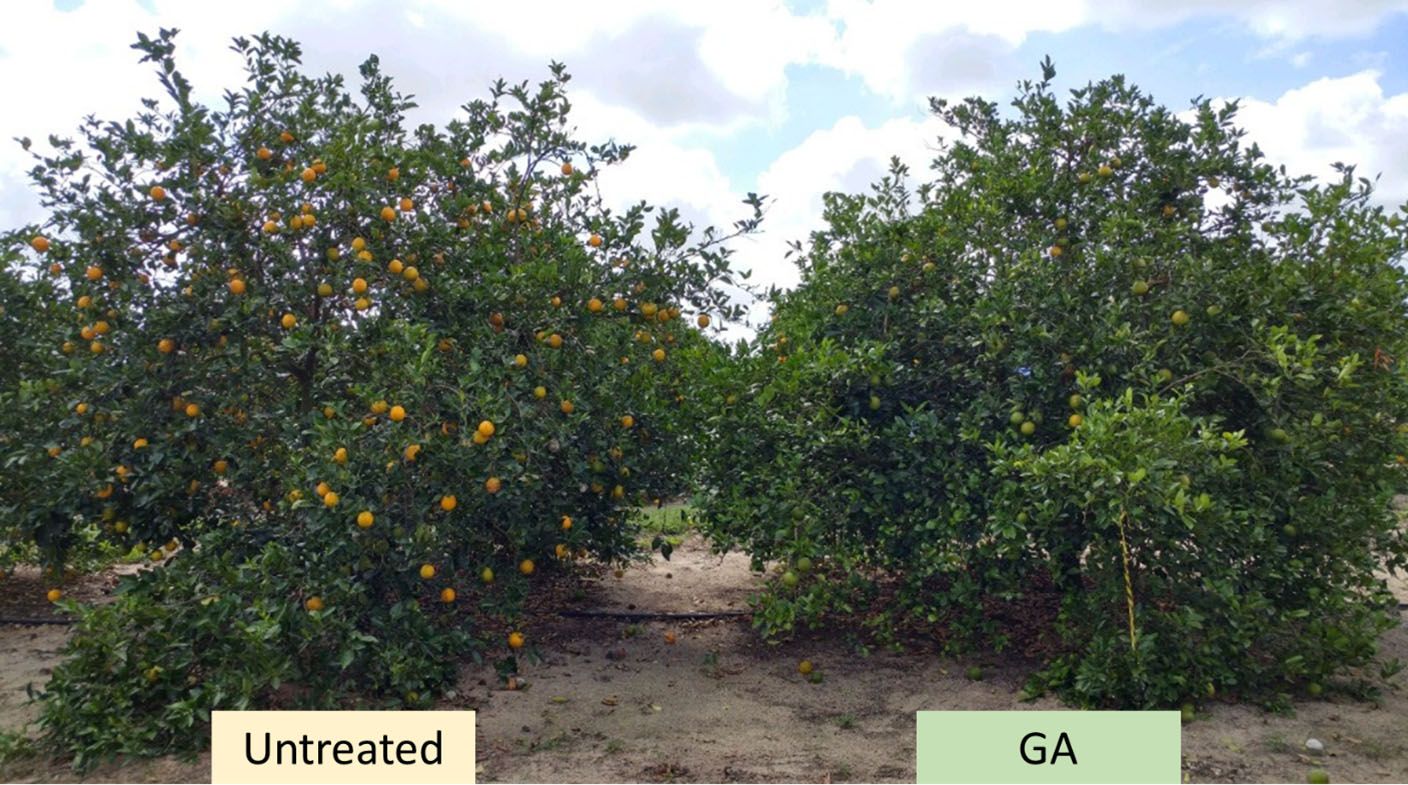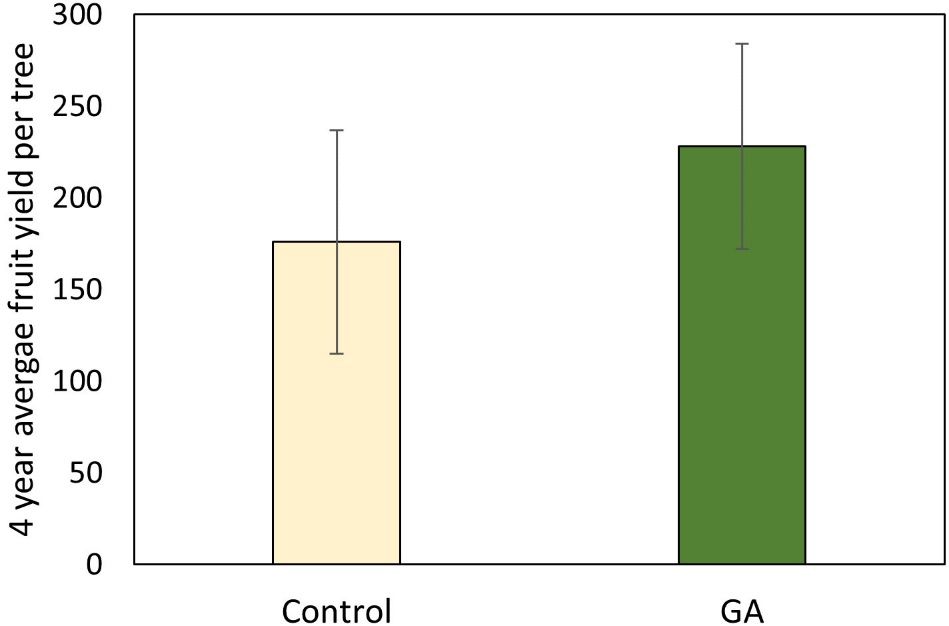The goal of this publication is to provide the latest gibberellic acid (GA) use recommendation to Florida citrus growers. Recently, a multiyear field trial conducted on ‘Valencia’ has shown that GA applied monthly from September to January can improve yield of HLB-affected trees on average by 30% compared to untreated trees. Although GA treatment cannot eradicate the pathogen that causes HLB in affected citrus trees, the current GA application recommendation can provide growers an alternative remedy to alleviate HLB symptoms and ameliorate the production issues that are associated with the disease, including yield decline, reduced fruit size, increased preharvest fruit drop, and rapid tree health decline, until a cure for HLB or complete HLB-resistant cultivars can be developed.
Background
Plant growth regulators (PGRs) are a tool used to manipulate vegetative and reproductive growth, flowering, fruit growth and development. Most PGRs are plant hormones, naturally occurring plant compounds. A plant hormone is a chemical signal produced in one part of the plant and then transported through vascular bundles to another part, where it triggers a response. Hormones regulate plant responses to various biotic and abiotic stimuli.
Gibberellins (GA) are a class of plant hormones widely used in fruit crop production in the United States and across the world to improve fruit set, growth, and development. Gibberellin biosynthesis is very complex. So far, more than 60 gibberellins have been discovered, including GA1, GA3, GA4, and GA7, but only a few are biologically active. GA4 and GA7 are used extensively in pome fruit production; in citrus fruit production GA3, gibberellic acid, has been found to be most effective. In this document, for ease of understanding, we will refer to GA3 as GA.
In citrus, late summer or fall applications of GA can delay fruit senescence and improve peel integrity. On the other hand, such GA applications delay changes in rind color (color break), resulting in fruit with green rinds. Spring application of GA is used to improve fruit set and growth, especially in varieties that struggle with fruitlet drop or inadequate flowering. Varieties with lower levels of GA in ovaries may be induced to set seedless fruit by applying GA, a well-known horticultural practice. Fall GA applications, around color break, have also delayed harvest by retaining fruit longer on the tree and reducing fruit drop. Altogether, GA has multiple uses in commercial production of citrus. However, the timing of applications is the most critical aspect for achieving the desired effect.
HLB and GA
Since the advent of huanglongbing (HLB) in Florida, there has been a significant observed increase in preharvest fruit drop and decrease in yield. Therefore, preliminary studies focused on use of GA application to reduce preharvest fruit drop were conducted. In these experiments, GA was applied once around color break at the start of fruit drop period. No consistent effect of GA on preharvest fruit drop reduction was found in those studies, and therefore, growers were discouraged from using GA. New research has shown that the signals for HLB-associated preharvest fruit drop arise months before the actual fruit drop begins. Therefore, any treatment or strategy to mitigate preharvest fruit drop should be applied before the fruit drop is observed. GA application during the fruit development period (fall) of ‘Valencia’ has shown to decrease preharvest fruit drop and, consequently, increase fruit yield.
Current Recommendations
Currently, there are no recommendations for use of GA on fresh fruit or early-maturing orange.
Based on the recent field trial (2016–2021), from September to January of each year, five monthly applications of GA at 20 g active ingredient per acre (or 33 mg per liter) with a nonionic surfactant is beneficial for HLB-affected ‘Valencia’ trees. The total spray volume depends on the tree size, and generally spray volume between 125 and 150 gallons per acre is required to ensure complete coverage of the tree. GA, being a plant hormone, interacts with multiple physiological processes in the plant. GA can reduce the flowering significantly, and therefore GA applications should not go beyond January 10 in Florida citrus-producing regions. Pay attention to biweekly floral bud induction advisories from UF/IFAS. If early flowering is predicted, GA application should end by December.
Currently, there are no specific guidelines for GA use on early-maturing sweet orange varieties. However, based on the current body of knowledge, GA application at 20 g active ingredient per acre (or 33 mg per liter) with a nonionic surfactant applied monthly from August through October is expected to improve fruit growth, reduce fruit drop, and improve yield. One major difference between ‘Valencia’ and early-maturing sweet orange spray regimes is that ‘Valencia’ GA applications overlap with the floral induction period, whereas the August through October application does not; hence, it is not expected to reduce flowering. Therefore, if reducing the total number of flowers and substituting it with spring vegetative growth is the major contributor of improved yield, the efficacy of GA in improving yield and productivity of early-maturing sweet orange may be lower than in ‘Valencia’. More research is needed before recommendations can be developed for early-maturing varieties.
GA applications are known to delay peel senescence and color change. The GA-treated fruit often remains green; therefore, the GA application should be carefully considered. Generally, a 2-to-4-month gap between the last GA application and anticipated harvest is ideal for fruit color development. For example, in the case of Hamlin, if GA is applied after mid-October, the harvest should be expected in January–February. Often growers don’t want to wait until January or February and want to get fruit harvested as soon as possible to escape the fruit drop. On the other hand, GA application can reduce fruit drop, slow the fruit aging process, and improve rind quality, allowing for the fruit to hang longer on the tree and delaying harvest. This can be a desirable scenario, especially in cases where processors and packinghouses are not accepting fruit early in the season.
Data from the field trials along with historical data suggests that when GA-treated fruit is harvested about 2–4 months after the last GA spray, the total soluble solid (°Brix) remains unaffected. However, warm spring temperatures seem to have a negative effect on GA-treated fruit. In 2020, when the average spring temperature was about 3°F higher than the historical average and higher than the previous four years, an interruption in Brix development was seen, but interestingly, no effect on juice acid was observed. Therefore, when warm spring is predicted, GA sprays should be withdrawn before January. However, the increase in yield may compensate for slightly lower Brix than untreated trees.
A list of GA products available for use in Florida citrus can be found in the UF/IFAS Florida Citrus Production Guide, chapter 45. Follow the label; the label is the law.
Details on the Field Trial
A field trial on use of GA to improve productivity of HLB-affected ‘Valencia’ trees was conducted from 2016 to 2021. In this trial, GA (Progibb LV Plus, Valent Bioscience) was applied at 20 g active ingredient (equivalent to 10 fl oz per acre) from September to January (5 monthly applications, each production season) with 0.125% nonionic, low-foaming surfactant (Induce, Helena Chemicals), 125–150 gallons total application volume. It should be noted that GA applications in this trial affected the flower induction period as well as the fruit development period. Take the crop harvested in spring 2018 for example: GA sprays in 2016–17 suppressed flowering in 2017, the resulting crop received another set of GA sprays during fruit development (from September 2017 to January 2018), and then it was harvested in spring 2018.
Some of the key findings over the four years of the trial are:
- With use of GA, flowering was synchronized and reduced by approximately 50%, and early flowering was suppressed.
- GA-treated trees maintained canopy density, whereas untreated trees declined in canopy (see the difference in canopy density in Figure 1).
- GA treatment increased average fruit size by 5%.
- GA-treated trees showed 10%–15% less fruit drop than untreated trees.
- GA-treated produced 50 pounds more fruit per tree on average (Figure 2, Table 1).
- GA-treated trees showed reduced starch buildup and better plant defense response, including alleviation of oxidative stress (a phenomenon caused by an imbalance between production and accumulation of oxygen-reactive species [ROS] in cells and tissues and the ability of a biological system to detoxify these reactive products), as compared to untreated trees.
- Fruit from GA-treated trees remained green externally (Figure 1).
- No detrimental effect of GA was observed on fruit Brix or titratable acidity (Figure 3).

Credit: Taylor Livingston, UF/IFAS CREC

Credit: UF/IFAS

Credit: UF/IFAS
How is GA helping the HLB-affected trees?
The effect of GA seems to be multipronged.
GA synchronized, reduced, and suppressed early flowering and increased fruit size. Sweet orange trees typically bloom profusely, and only a minimal number of flowers (<1%) turn into harvestable fruit. In other words, a significant amount of resources used for flower formation are lost during the production season due to flower and fruit abscission. Many citrus cultivars have demonstrated an inverse relationship between flower number and subsequent fruit size unrelated to crop load. In addition, GA application can result in increase in leafy inflorescences. Leafy inflorescence in citrus sets more and develop better and bigger fruit than leafless inflorescence.
In citrus, GA suppresses floral development by continuing the vegetative development of the shoot apical meristem when applied before buds become determined to flower formation. Consistently, the canopy density was maintained in GA trees, whereas there was a significant decrease in canopy density in untreated control trees. A 10% decline in canopy of density of untreated trees was observed whereas the canopy of the GA-treated trees remained unchanged. Shoot dieback is a classic HLB symptom. In HLB-affected sweet oranges, canopy density is positively correlated with fruit size, mature fruit retention, and overall yield.
Leaves and fruit peduncles showed improved hormonal balance, plant defense response, and photosynthesis in GA trees compared to control trees, thereby contributing to better tree vitality, indicated by the canopy density, and fruit production for ‘Valencia’ sweet orange in the presence of HLB.
Summary
Overall, the field trial suggests a beneficial effect of foliar-applied GA on HLB-affected trees. The GA applications seem to have a multipronged benefit for HLB-affected ‘Valencia’ sweet orange trees, through which a significant improvement in yield is achieved. First, the reduction in spring flower intensity by GA treatment is analogous to flower thinning, which reserves tree resources for other developmental processes including fruit development; second, GA treatment increases vegetative shoot development to negate branch dieback caused by HLB, thereby sustaining the canopy vigor and possibly, improving the source-to-sink ratio. Third, GA application on developing fruit improves fruit size and fruit retention. Finally, GA application can improve plant defense responses and reduce oxidative stress.
Table 1. Yield of untreated and GA-treated ‘Valencia' trees.